ProjectBiddit.app Study Planning
TL;DR
Biddit evolved from a semester planning tool to a comprehensive study program planner, addressing multi-semester dependencies and providing detailed features such as semester summaries, transcripts, study overviews, and placeholder courses. The updates improved usability and engagement, with user numbers increasing by 197% during the bidding phase and overall engagement up by 326.8% throughout the semester. Despite some initial testing challenges, the new features have significantly enhanced the planning experience for students at the University of St. Gallen.
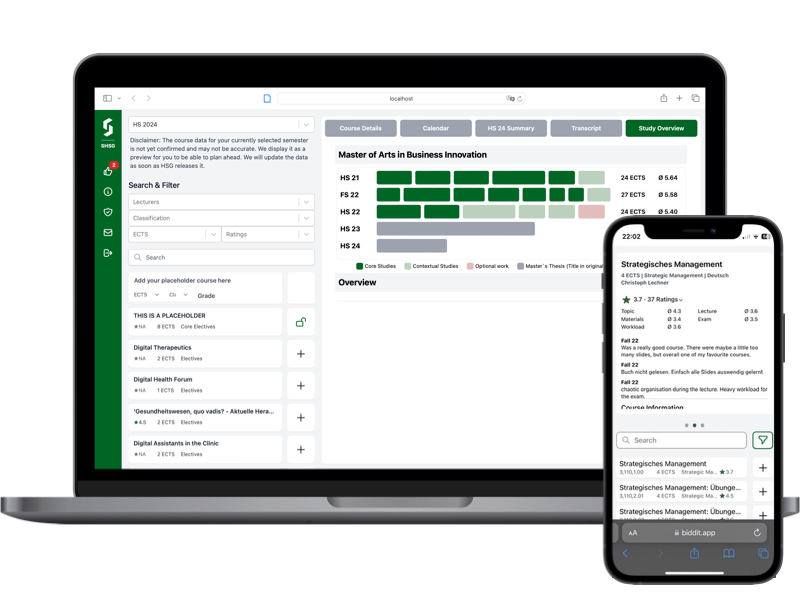
Problem
Planning each semester on its own is useful, but students often have to deal with dependencies that span multiple semesters. Most study programs come with specific requirements, usually needing a certain number of courses or credits from different categories like compulsory and elective courses, which we’ll call "buckets."
When planning their next semester, it's crucial for students to keep track of which buckets they've already completed and which ones still need more courses. This helps spread the workload evenly across different semesters. Plus, many students plan to study abroad or take on full-time internships, adding more layers to their planning process.
The old version of Biddit couldn't handle these extra considerations, making it tough for students to plan their entire academic journey. We saw that allowing students to plan multiple semesters ahead was the next logical step for Biddit. Our vision was to evolve Biddit from just a semester planning tool to a full-fledged study program planning tool, helping students from start to finish in their academic careers.
Approach
One approach would have been to simply take the previous version of Biddit, add a dropdown to select a semester, and call it a day. However, we knew that this wouldn't be sufficient. Instead, we decided to take this opportunity to restructure the application, update existing features, and add new ones.
There were a few issues with the previous version we also wanted to fix:
- User feedback indicated that accessing course details—one of our key value propositions of having everything in one place—was not intuitive enough. Users could access details by clicking on the course name, but this wasn't obvious to many.
- The previous UI allocated a lot of screen real estate to the calendar, which was the default view. While the calendar is important, it's not the first step in planning the upcoming semester. Getting an overview of the courses and their content is.
- The space reserved for the semester summary, including the overview of lectures per course, exams, and credits by bucket, was too limited to integrate more granular tools.
- The option to filter courses by criteria such as bucket, professor, or rating was hidden behind a button, making it less accessible.
In addition to these improvements, we also wanted to address the following user stories:
- As a user, I want to be able to quickly get an overview of my workload throughout the week so I can plan extracurricular activities (job, sports, etc.) accordingly.
- As a user, I want to be aware of my progress towards graduating so I can select only courses for buckets I haven't completed yet.
- As a user, I want to get a grip on my grades and see how I can improve my overall GPA.
- As a user, I want to understand how many credits I am taking each semester to decide how many credits I need to take next.
- As a user, I want to include courses I am going to take during a semester abroad so I don't take too many.
By addressing these issues and user stories, we aimed to transform Biddit into a comprehensive study program planning tool, making it easier for students to plan their academic journey from start to finish.
Solution
The main updates can be summarized in four categories, each described below:
Overall Changes
To free up more space, we decided that there should be two dedicated areas:
- Searching, filtering, and selecting courses
- Deep diving into courses and the semester plan

By moving the analytics to dedicated tabs on the right-hand side, we freed up more pixels for the course list and were able to display the search bar and filters permanently. Additionally, we now had more space to work with for the different analytics components, including course details, the weekly calendar, semester and study program overviews, and the transcript. Users still have the option to see how changes in the selected courses affect their semester without being bombarded with different information all at once.
Semester Summary
- As a user, I want to be able to quickly get an overview of my workload throughout the week so I can plan extracurricular activities (job, sports, etc.) accordingly.
When studying, especially in higher semesters, students often work part-time (usually between 1-2 days/week) in addition to their studies. The best way to make this work is to plan one fixed day of the week. This also provides employers with predictability and helps them make schedules. To help students better integrate those responsibilities, we created a new type of schedule, similar to a heatmap, in addition to the already existing week-by-week calendar. Students can now see if and how many lectures they have per day for the entire semester, ordered by the day of the week. This makes it easy to spot days with no or only a few lectures that might be suitable for a "work" day. We call this the Semester Summary.

By hovering over the tiles, students can also see which courses they have on a given day.
Transcript
- As a user, I want to be aware of my progress towards graduating so I select only courses for buckets I haven't completed yet.
- As a user, I want to get a grip on my grades and see how I can improve my overall GPA.
While studying can be a lot of fun, in the end, it is about completing a program and getting the degree while optimizing the grades. This usually includes collecting a certain number of credits for predefined buckets of courses. Therefore, keeping track of one's progress and planning courses accordingly is key. To make this easier, students now have access to their entire grade transcript directly in Biddit, something they previously had to access through yet another university tool.
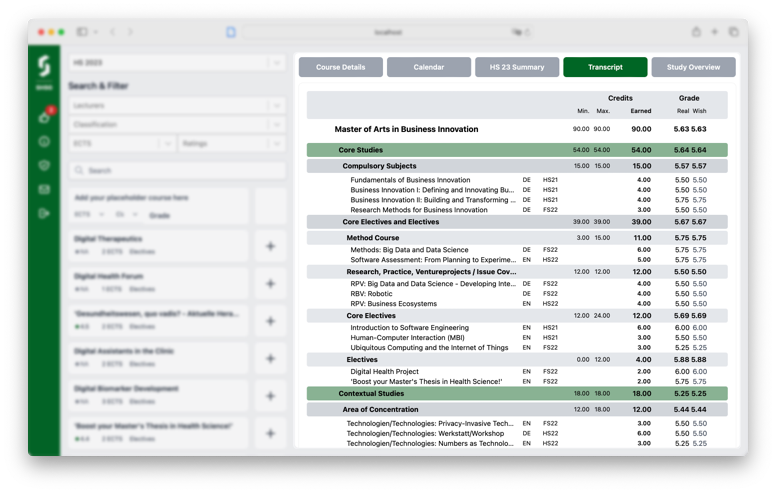
The completed and selected courses, including the title, the semester it was taken, the grade, and credits, are listed by buckets and sub-buckets. The credits per bucket needed (min & max) and completed are also displayed. There is also an indicator for when more credits are selected than needed, helping students avoid taking more credits than required by accident. For uncompleted courses, students can also add the grade they expect to receive and see its impact on the overall grade average.
Study Overview
- As a user, I want to understand how many credits I am going to take each semester to decide how many credits I need to take next.
The study overview helps students maintain a balanced workload throughout their entire study program. Additionally, this is a great place to plan bigger aspects such as a semester abroad, the thesis, or an internship.
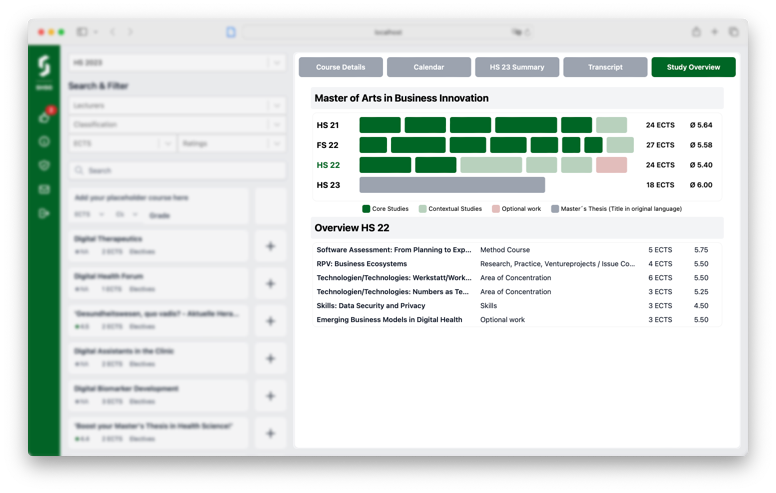
Placeholder Courses
- As a user, I want to be able to include courses I am going to take during a semester abroad so I don't take too many.
When taking a semester abroad, transferring the credits can sometimes be challenging. Yet, they are important to remember when planning future semesters. Therefore, users can now create so-called "Placeholder Courses." These courses can be defined by the user, including the title, the bucket, and the number of ECTS credits. Placeholder courses and their credits will also be included in the preliminary transcript, the study overview, and anywhere the total number of credits is important. Besides representing courses during a future semester abroad, placeholder courses can also be used for the thesis or other courses that are not yet officially available.
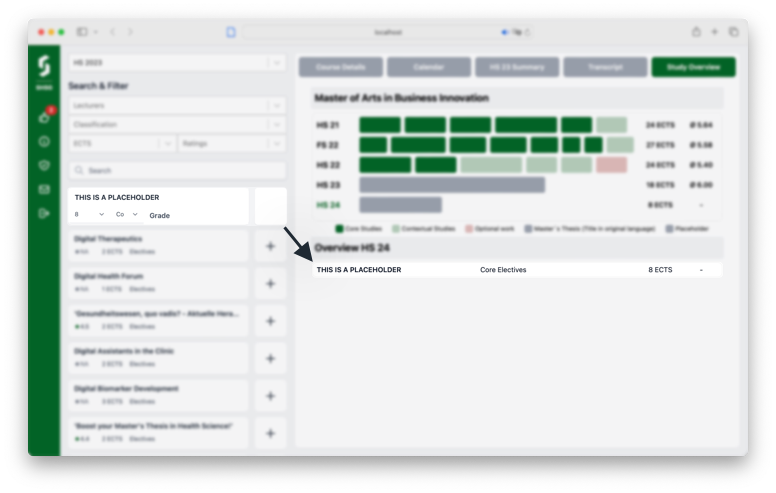
By addressing these areas, we transformed Biddit into a comprehensive study program planning tool, making it easier for students to plan their academic journey from start to finish.
Challenges
During this project, we encountered two key problems:
Data for Future Semesters
The University of St. Gallen typically publishes the list of courses only one semester in advance. This lack of long-term data is at odds with planning an entire degree, which usually spans 6-8 semesters for a bachelor's degree and 3-6 for a master's. However, we noticed that certain courses, especially compulsory ones, are usually offered every year. By analyzing course numbers from past semesters, we found that roughly 80% of courses are available every other semester (Fall semester -> Fall semester & Spring semester -> Spring semester).
Therefore, we extrapolate the courses for each user into the future and replace them automatically as soon as the actual course list is published. While this approach is not perfect, it still provides significant benefits to users. We also ensure to inform users about the source of the data:
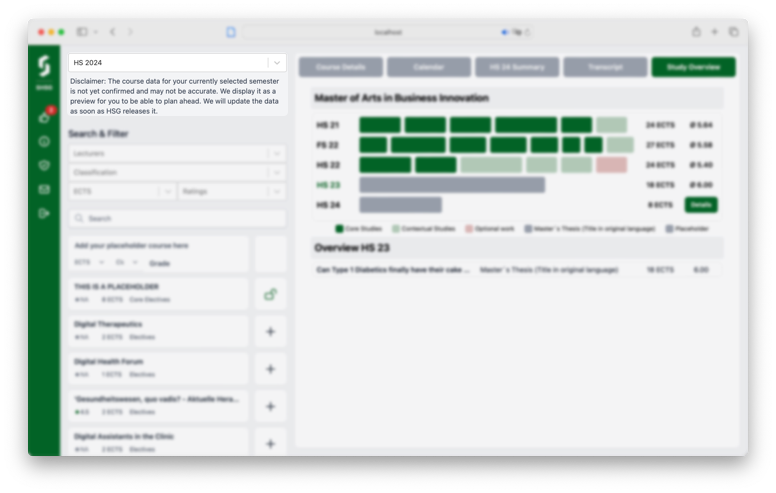
Testing
Another significant challenge we faced, and are still dealing with, is the rigorous testing of the application. Testing the application requires both the logic (code) and the data (university & SHSG APIs). While we have full control over the logic, we only have access to the data associated with our personal university user accounts. This limitation significantly reduces our testing coverage.
To counteract this, we recruited a group of SHSG students to test the application on a development deployment before pushing any changes to production. However, the University of St. Gallen offers two Assessment Year programs (first year of the Management & Computer Science Bachelor programs), seven Bachelor programs, fifteen Master programs, and six Doctorate programs. Additionally, some programs are offered in both English and German, and some exist in different versions due to curriculum and program structure changes. Moreover, there are double degree programs, additional certifications, and tracks that add to the complexity. The study program information was not required in the previous version of Biddit.
Despite our efforts, we could not anticipate and catch all the combinations and edge cases during testing, which led to client-side errors for some users, resulting in a white screen.
After being made aware of the issue, I quickly implemented several actions:
- Implemented React Error Boundaries to catch and handle errors locally, ensuring that users could still use other parts of the application.
- Re-hosted the previous version, which was independent of the program requirements.
- Added an option for users to send us their errors so we can pinpoint and resolve the issue.

These measures have helped improve the robustness of the application, but we continue to work on refining our testing processes to catch more edge cases and ensure a smooth user experience.
Impact
During the bidding phase for the Spring Semester 2023, we saw an impressive increase in the number of users by 197% compared to the year before.
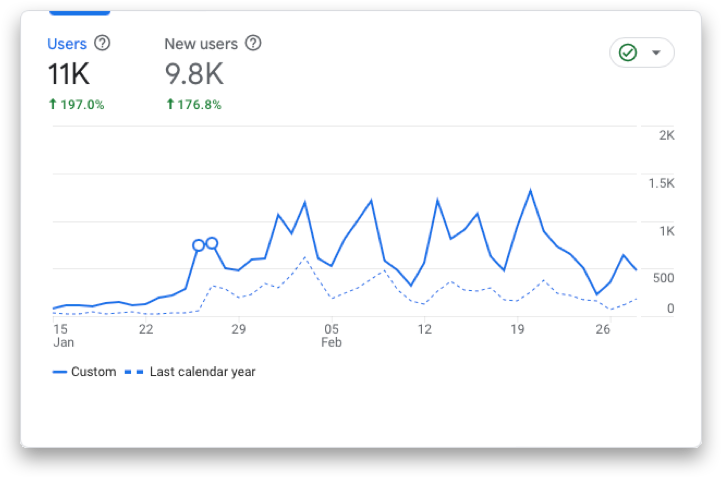
While some of this increase in usage can be attributed to the acquisition by the student union, much of it is due to the new features we implemented. The biggest indication of this is the sustained usage throughout the semester, which increased by 326.8%. On weekdays during the semester, between 100-200 people were using Biddit each day.
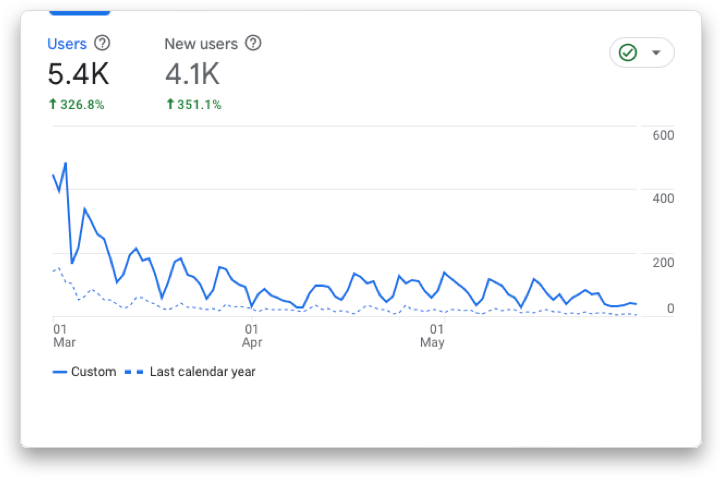
All other metrics, including Average Engagement Time, Average Engagement Time per Session, Number of Views, and Number of Events, also saw significant increases. This data suggests that the new features have not only attracted more users but also kept them engaged and actively using Biddit throughout their academic planning.
These improvements highlight the positive impact of the updates and reinforce our commitment to continuously enhancing the Biddit experience for students.
Conclusion
Overall, I am quite satisfied with the success of this project. Biddit is now more powerful and helpful to students than ever. However, I think that we got too excited. We added to many features at once and lowered our bar for the quality of work we want to release. Many of the new functionalities feel more like cool ides rather tha refined features.
We should never compromise on our standards.